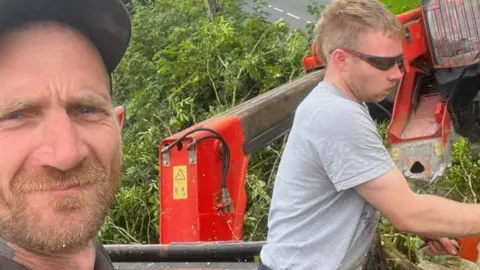In a gripping tale of friendship gone awry, the downfall of best mates Daniel Graham and Adam Carruthers unfolded dramatically when they were involved in the illegal felling of the iconic Sycamore Gap tree. Once inseparable companions who spent countless hours together, their relationship took a turbulent turn, culminating in their shared appearances in court to face charges.
Daniel and Adam became friends about four years prior to the incident. Their camaraderie strengthened when Carruthers, a mechanic, did Graham a significant favor by repairing his father’s Land Rover in preparation for the latter’s father’s funeral. This act of kindness reciprocated with a series of collaborative opportunities where they worked side-by-side, often taking on jobs that included felling trees, from which they split earnings, thereby enhancing their bond further.
However, the serenity of their friendship shattered during Storm Agnes in September 2023, when, under the shroud of night, the duo decided to cut down the famed Sycamore Gap tree. Their audacious venture was reportedly carried out with careful planning, allowing them to take advantage of the heavy winds that provided natural cover. The men scaled marshland, marked the tree trunk, and executed the felling process, filming the experience as a form of twisted amusement. Little did they know, their actions would be recorded and tracked through their technology, leading to unforeseen consequences.
As investigators delved deeper into the incident, the friendship between the two men began to unravel. Graham’s mobile device captured the felling, while CCTV footage adorned the roads leading to the tree, marking out his Range Rover. Subsequently, he attempted to distance himself from the deed, claiming that his vehicle and phone were used without his consent—an assertion that evoked disbelief from the prosecution. Comments from prosecutor Richard Wright suggested incredulity over Graham’s defense, highlighting the implausibility of his claims while presenting a picture of their deteriorating friendship.
Carruthers, too, found himself embroiled in a web of lies and fabrication. When questioned, he connoted a tale about taking his partner out for a meal to explain his presence near the infamous tree. However, the court scrutinized his alibi, questioning the credibility of his stories regarding a meal out post childbirth. Throughout this period, the dynamic between the two men morphed into that of adversaries, rather than companions.
The court sessions revealed a dramatic fallout between them, where Carruthers’ representative characterized Graham’s attempts to shift blame as desperate acts of self-preservation and scapegoating. Allegations rose that Graham named Carruthers as the main perpetrator merely to protect himself, further fracturing their bond. Previously allies who confided in each other, they were now bitterly contesting narratives in a harsh legal environment.
Months after the incident, Graham anonymously reported Carruthers to the police, marking a definitive end to their friendship. The fallout exemplified how quickly kinship can dissolve under the weight of guilt and external pressure. Both men, once best friends, faced the same harsh reality—caught between the remnants of their camaraderie and the consequences of their impulsive decision to destroy a beloved natural landmark that had stood for over a century.
In the final hours of their trial, as the jury prepared to deliberate, emotions surged, with confrontations erupting even outside the courtroom. The bond of trust had collapsed, leaving both men burdened with guilt and the heavy weight of their actions. Although both were implicated in the crime surrounding the controversial act against nature, neither was willing to fully reclaim their responsibility, resulting in a powerful narrative on the breaking point of friendships in the face of judgment and condemnation.
This tale serves as a cautionary reflection on friendships built on questionable foundations, the fragility of alliances, and the lengths to which individuals might go to seek self-preservation in the wake of shared wrongdoing. As the world mourns the loss of a cherished natural spectacle, the story of Graham and Carruthers remains as an indelible reminder of their misguided choices.



